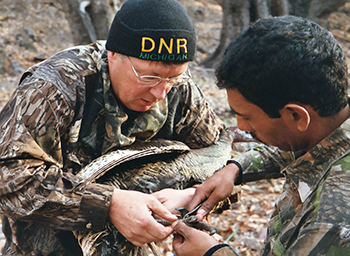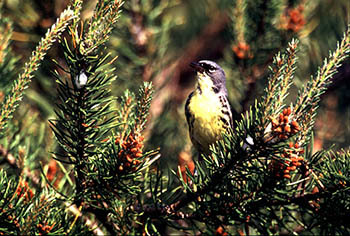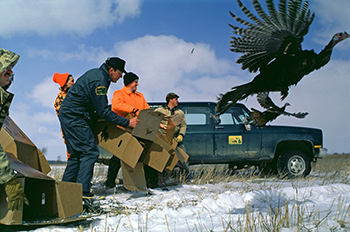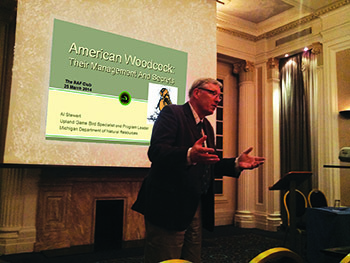From grizzlies to grouse, tracking the steps of a DNR wildlife conservation pioneer
Editor’s note: In celebration of the department’s centennial anniversary, the Showcasing the DNR feature series will highlight one story each month during 2021 that recalls various accomplishments of the department over the past century.
By CASEY WARNER
Michigan Department of Natural Resources
Although he would spend much of his 50-year career with the Michigan Department of Natural Resources focusing on upland game birds like wild turkeys and grouse, it was grizzly bears that first sparked Al Stewart’s interest in working with wildlife.
As a boy, Stewart saw a popular 1960s National Geographic television special featuring the Craighead brothers, researchers known for their groundbreaking study of grizzly bears in Yellowstone National Park.

“That really caught my interest,” Stewart said. “I thought I wanted to be a wildlife veterinarian, and that’s what I thought the Craigheads were because they caught these big grizzly bears and used large culvert traps and gave a drug and put neck collars on them and followed them around, so that was pretty exciting and that’s what I thought I wanted to do.
“That was before Animal Planet.”
Beginnings
The DNR celebrates its centennial this year, and Stewart – who recently retired – was there for half of that 100 years. He shared some reflections on the department’s story and his role in it.
Stewart’s introduction to working with the DNR came while he was a student at Michigan State University in 1970, when the university provided some funding for him to help with wildlife research at the Rose Lake Wildlife Pathology Lab in Clinton County.
In 1972, after graduating from the MSU animal technology program, he was hired to work for the DNR as a student assistant at the Rose Lake Wildlife Pathology Lab. As he learned more about the field of wildlife biology, he realized that’s the career he wanted and continued his studies in that field, earning a degree in 1975.
|

Describing his time at Rose Lake, Stewart said, “While I was at the lab, I got to work on a lot of really outstanding projects that helped shape my interests.”
For example, he worked on a project to study attributes of turkey health that involved trapping wild turkeys in the northern Lower Peninsula and taking samples from them.
“I was there when the nets went over the turkeys and I said, ‘boy, that’s really cool, I’d really like to do this in the future.’ And so that was the starting of my very strong interest in wild turkeys. In those days there weren’t many wild turkeys really to speak of in Michigan, so that was a very unique experience.”
In his early days with the DNR, Stewart also was involved in activities to monitor and reintroduce giant Canada geese, which were close to extinction in the 1960s, to Michigan.
He called the Canada goose reintroduction effort “a great success to the point that some may say they are a nuisance. But still, Michigan is ranked as one of the top in the nation for Canada goose harvest and continues to be a leader in Canada goose management.”
|

Another project entailed collecting loons that had died from botulism along the shores of Lake Michigan.
“I found out very rapidly that loons are pretty heavy,” said Stewart, who had to walk up dunes with plastic bags of loons weighing about 100 pounds. “It was a lot more work than I expected … I thought I was just a beachcomber … but I loved every minute of it.”
Conservation milestones
Stewart also was involved in the effort to recover the Kirtland’s warbler, a species that was on the brink of being extinct in the early 1970s. He helped Bill Shake, USFWS biologist, on trapping brown-headed cowbirds, which helped prevent these parasitic birds from laying eggs in Kirtland’s warbler nests and causing warbler parents to care for cowbird chicks instead of their own chicks. He got to participate in Kirtland’s warbler singing surveys to help monitor the species’ population.
Today, thanks to the work of many conservation partners including the DNR, Kirtland’s warblers have made a remarkable recovery and no longer need Endangered Species Act protection.
Other interesting assignments while Stewart was working out of the wildlife lab included collecting bats to test for rabies and testing foxes for rabies and taking part in elk surveys and research into winter deer nutrition.
“I had a hodgepodge of great experiences on the front end of my career,” he said. “I was real lucky to have been able to do that.”
|

After leaving the wildlife lab, Stewart worked as a wildlife technician in the Thumb area of Michigan, where he worked on pheasant and grouse management. He then was a wildlife biologist in Pontiac, where he interacted with sportsmen’s clubs in the Detroit area, did waterfowl check station work at Harsen’s Island and “got to see the urban side of wildlife.” Here he helped to develop some of the early programs for managing nuisance Canada geese.
He then transferred back to the Rose Lake field office, where he was responsible for Maple River State Game Area and other game areas in Clinton and Gratiot counties.
At the time, the Maple River game area had become overgrown, the water pumps were malfunctioning, and there were holes in the dikes. Stewart helped redesign the area’s units, and now it features “the largest wetland complex in mid-Michigan, with a lot of waterfowl.”
While working out of the Rose Lake office, he applied for a grant to create the first barrier-free blind in Michigan, a duck hunting and waterfowl observation blind at Maple River. He enlisted a huge army of volunteers to help in that effort, including at-risk youth, students at local schools, Boy Scouts and duck hunting organizations.
The project and the outreach that went into it earned Stewart the Teddy Roosevelt Conservation Award, which was presented by President George H. Bush at the White House, in 1992.
“I got to have lunch with him – it was pretty cool,” Stewart said.
Nearly 30 years later, making Michigan’s natural resources and outdoor recreation opportunities accessible to everyone is a key DNR priority.
Stewart also submitted one of the first proposals for funding from the Nongame Fish and Wildlife Trust Fund, established in 1983 to help conserve and promote awareness and appreciation of Michigan's endangered, threatened and nongame wildlife. That proposal, to build a wildlife observation tower at Maple River, became the first nongame fund project ever funded.
|

The nongame fund also led to another project he played a big role in – reintroducing the osprey, a once-threatened bird species that’s now thriving in urban areas, to southern Michigan.
“l wrote the original plan for that, and now we have ospreys throughout southern Michigan, so that was really a big plus,” Stewart said.
Another bird Stewart helped reintroduce to southern Michigan was the wild turkey.
Ever since his work with the birds at the wildlife lab early in his career, he was “enthralled by wild turkeys” and said he always had wanted to do something to reintroduce them to southern Michigan and expand their range in Michigan.
He got that chance in 1983, when he, along with many others, brought wild turkeys to Michigan from Iowa and Missouri and established some flocks in the southern part of the state.
Stewart was in charge of teaching DNR staff how to trap offspring of those birds to then move them to other locations in the state to help expand this restoration activity.
“So today, Michigan ranks fourth in the nation for wild turkey harvest … We’ve gone from extirpation of all wild turkeys in Michigan to today we have over 200,000 birds, and you can hunt turkeys in every county in the state,” he said. “That’s a pretty rewarding feeling to know that I was one small part of a project like this. It has brought so much pleasure and enjoyment to people either in viewing wild turkeys and knowing they were there or the ability to hunt in both the spring and fall.”
More accomplishments
After his time at the Rose Lake field office, Stewart transferred to Lansing to become the DNR’s upland game bird specialist and spent over 20 years in that role. He worked on projects like creating Michigan’s grouse enhanced management sites, known as GEMS, for premier bird hunting and Turkey Tracts, public hunting areas with habitat intensively managed for turkeys.
|

“We created some of the highest-quality sustainable turkey hunting in the nation,” he said. “That says a lot when your competitors for that are places like Missouri, that is the best wild turkey habitat in the world and the highest population. They don’t have deep snow.”
Later in his career, Stewart saw a project he started while working as a biologist at Rose Lake – where one of his responsibilities was the game area’s rifle range – come to fruition. The range started as an old gravel pit where people shot rifles and pistols, and over time, the DNR helped improve it.
“I got responsibility for the range at a time when shooting ranges were first starting to gain more interest from people,” Stewart said. “I applied for some grants and helped to update the range. We completely redid the whole range, moved a lot of earth around, helped make it barrier-free.”
The range improvement was supported with Michigan Natural Resources Trust Fund dollars, and the first marker for Trust Fund projects was placed at Rose Lake.
He had plans to build a grant-funded shooting education building at the range, but the plans got waylaid as responsibility for shooting ranges moved between DNR divisions.
Later, through Stewart’s association with the Glassen Foundation, the DNR was able to build the state-of-the-art Hal and Jean Glassen Shooting Education Center, with accessible classroom and meeting space for up to 80 people, adjacent to the Rose Lake shooting range.
“And now I can sleep at night,” he said.
Part of Stewart’s role as the DNR’s upland game bird specialist was studying the American woodcock, and he saw advances in woodcock research methods over the years.
|

Michigan has a long-running woodcock banding program pioneered by his predecessor, Andy Ammann.
“We’ve been able to expand on that, and Michigan bands more woodcock chicks than anywhere else in the world and has the longest-running database on banded woodcock in the world, with over 34,000 birds having been banded. And there’s no other program even close,” he said.
“Michigan is No. 1 in the world for American woodcock harvest. We’re a leading production state, thanks to the work our biologists and forest management do as far as managing aspen and young forests and working with private landowners to manage their properties. Michigan is a real focal point for woodcock nationally.”
But, as Stewart explained, banding alone doesn’t provide any data between when a bird is banded and when it is recovered. As technological developments allowed solar satellite transmitters to be made small enough to put on a small bird like a woodcock, Michigan became one of the first places to be involved in satellite telemetry for monitoring the species.
Stewart was invited to work with biologists in England and brought their knowledge of woodcock satellite telemetry back to Michigan and helped other research partners get that project going here.
“It helped us move our knowledge about American woodcock from a lower level to a whole other plateau of knowledge about movement of the birds,” he said.
Michigan hosted international woodcock symposia that brought people together to talk about the status of the birds now and where they want to be into the future and, from that, helped write best management practices for woodcock.
Because of Stewart’s activities with woodcock, he was invited to speak at an international woodcock symposium in Italy and, more recently, at Highgrove House in the U.K., the private residence of Prince Charles.
Throughout his career, Stewart has been known for his leadership, innovative ideas and mentoring skill. He has mentored many prospective and current natural resource employees while they were students and throughout their career. He’s quick to point out how fortunate he feels to have worked with so many devoted resource professionals in his job.
Al Stewart’s journey with the DNR took him not only around the world, but through five decades of changes and advancements in wildlife management.
His dedication help shaped who the DNR is as it heads into the next century of caring for Michigan’s natural resources.
|
Check out previous Showcasing the DNR stories in our archive at Michigan.gov/DNRStories. To subscribe to upcoming Showcasing articles, sign up for free email delivery at Michigan.gov/DNR.
/Note to editors: Contact: John Pepin, Showcasing the DNR series editor, 906-226-1352. Accompanying photos and a text-only version of this story are available below for download. Caption information follows. Credit Michigan Department of Natural Resources, unless otherwise noted.
Text only version - Showcasing - Stewart
GEMS: Al Stewart talks to elementary school students who participated in a habitat project at the first Grouse Enhancement Management Site (GEMS) on Drummond Island.
Maple River: A ribbon-cutting dedication for the barrier-free hunting/wildlife observation blind at Maple River State Game Area is pictured. Al Stewart (second from left) earned the Teddy Roosevelt Conservation Award in 1992 for his work on the project.
Net: Al Stewart sets a mist net to trap woodcock as part of a solar satellite transmitter project.
Presentation: Al Stewart talks about woodcock management during an international presentation he gave in the United Kingdom in 2014.
Release: Wild turkeys from Iowa are released in Clinton County as part of the southern Michigan wild turkey restoration program in the 1980s. Pictured are Al Stewart (in green) and some of the Michigan Department of Natural Resources’ partners involved in the project.
Rose Lake: At the Rose Lake State Wildlife Area in 1985, Al Stewart (right) answers a deer hunter’s question.
Stewart: Al Stewart stands at a gate to the Goldmine GEMS in Iron County in 2015.
Tracts: Al Stewart (second from left) and other DNR staff members and partners at the launch of the Turkey Tracts program – which has created unique turkey hunting areas across the Lower Peninsula, providing excellent opportunities for a variety of hunters, including youth, adults new to the sport and seniors – at Allegan State Game Area in 2016.
Turkey: As part of a national Gould's turkey restoration program to trap turkeys in Mexico and relocate them in Arizona, Al Stewart (left) – widely known for his expertise during his career as the DNR’s upland game bird specialist – mentors a Mexican biologist in trapping the birds.
Warbler: A photo of a Kirtland’s warbler is shown perched in a jack pine tree in the Lower Peninsula.
Woodcock: Al Stewart holds an American woodcock during a banding effort in Gladwin County in 2010./
|